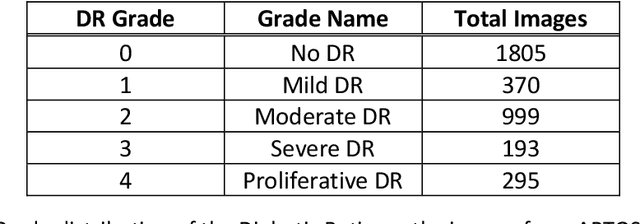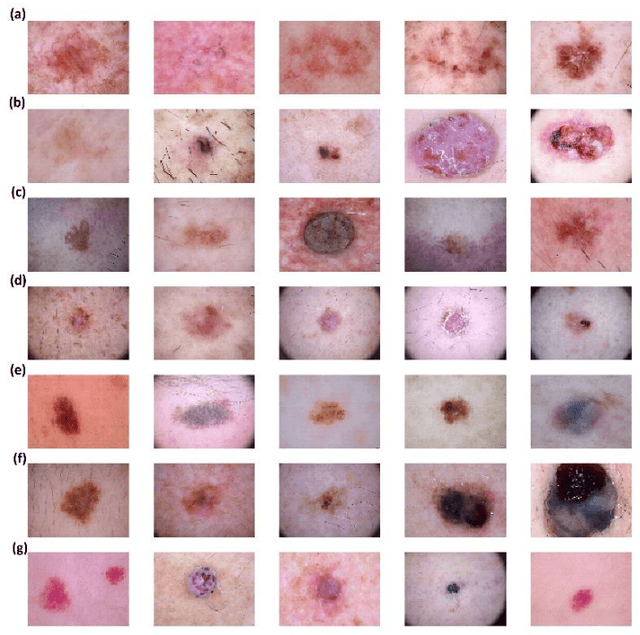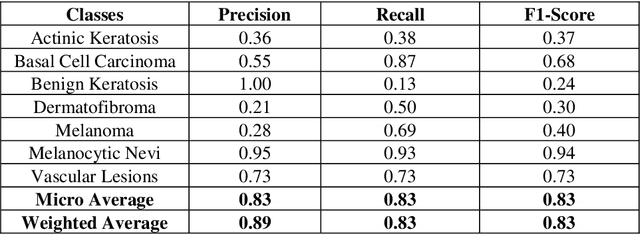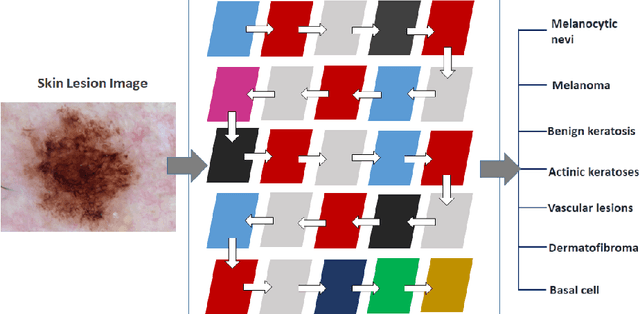Kajol Gupta
Automated Diabetic Retinopathy Grading using Deep Convolutional Neural Network
Apr 14, 2020



Abstract:Diabetic Retinopathy is a global health problem, influences 100 million individuals worldwide, and in the next few decades, these incidences are expected to reach epidemic proportions. Diabetic Retinopathy is a subtle eye disease that can cause sudden, irreversible vision loss. The early-stage Diabetic Retinopathy diagnosis can be challenging for human experts, considering the visual complexity of fundus photography retinal images. However, Early Stage detection of Diabetic Retinopathy can significantly alter the severe vision loss problem. The competence of computer-aided detection systems to accurately detect the Diabetic Retinopathy had popularized them among researchers. In this study, we have utilized a pre-trained DenseNet121 network with several modifications and trained on APTOS 2019 dataset. The proposed method outperformed other state-of-the-art networks in early-stage detection and achieved 96.51% accuracy in severity grading of Diabetic Retinopathy for multi-label classification and achieved 94.44% accuracy for single-class classification method. Moreover, the precision, recall, f1-score, and quadratic weighted kappa for our network was reported as 86%, 87%, 86%, and 91.96%, respectively. Our proposed architecture is simultaneously very simple, accurate, and efficient concerning computational time and space.
Digit Recognition Using Convolution Neural Network
Apr 01, 2020


Abstract:In pattern recognition, digit recognition has always been a very challenging task. This paper aims to extracting a correct feature so that it can achieve better accuracy for recognition of digits. The applications of digit recognition such as in password, bank check process, etc. to recognize the valid user identification. Earlier, several researchers have used various different machine learning algorithms in pattern recognition i.e. KNN, SVM, RFC. The main objective of this work is to obtain highest accuracy 99.15% by using convolution neural network (CNN) to recognize the digit without doing too much pre-processing of dataset.
Advances in Computer-Aided Diagnosis of Diabetic Retinopathy
Sep 21, 2019
Abstract:Diabetic Retinopathy is a critical health problem influences 100 million individuals worldwide, and these figures are expected to rise, particularly in Asia. Diabetic Retinopathy is a chronic eye disease which can lead to irreversible vision loss. Considering the visual complexity of retinal images, the early-stage diagnosis of Diabetic Retinopathy can be challenging for human experts. However, Early detection of Diabetic Retinopathy can significantly help to avoid permanent vision loss. The capability of computer-aided detection systems to accurately and efficiently detect the diabetic retinopathy had popularized them among researchers. In this review paper, the literature search was conducted on PubMed, Google Scholar, IEEE Explorer with a focus on the computer-aided detection of Diabetic Retinopathy using either of Machine Learning or Deep Learning algorithms. Moreover, this study also explores the typical methodology utilized for the computer-aided diagnosis of Diabetic Retinopathy. This review paper is aimed to direct the researchers about the limitations of current methods and identify the specific areas in the field to boost future research.
Skin Lesion Analyser: An Efficient Seven-Way Multi-Class Skin Cancer Classification Using MobileNet
Aug 03, 2019



Abstract:Skin cancer, a major form of cancer, is a critical public health problem with 123,000 newly diagnosed melanoma cases and between 2 and 3 million non-melanoma cases worldwide each year. The leading cause of skin cancer is high exposure of skin cells to UV radiation, which can damage the DNA inside skin cells leading to uncontrolled growth of skin cells. Skin cancer is primarily diagnosed visually employing clinical screening, a biopsy, dermoscopic analysis, and histopathological examination. It has been demonstrated that the dermoscopic analysis in the hands of inexperienced dermatologists may cause a reduction in diagnostic accuracy. Early detection and screening of skin cancer have the potential to reduce mortality and morbidity. Previous studies have shown Deep Learning ability to perform better than human experts in several visual recognition tasks. In this paper, we propose an efficient seven-way automated multi-class skin cancer classification system having performance comparable with expert dermatologists. We used a pretrained MobileNet model to train over HAM10000 dataset using transfer learning. The model classifies skin lesion image with a categorical accuracy of 83.1 percent, top2 accuracy of 91.36 percent and top3 accuracy of 95.34 percent. The weighted average of precision, recall, and f1-score were found to be 0.89, 0.83, and 0.83 respectively. The model has been deployed as a web application for public use at (https://saketchaturvedi.github.io). This fast, expansible method holds the potential for substantial clinical impact, including broadening the scope of primary care practice and augmenting clinical decision-making for dermatology specialists.
 Add to Chrome
Add to Chrome Add to Firefox
Add to Firefox Add to Edge
Add to Edge